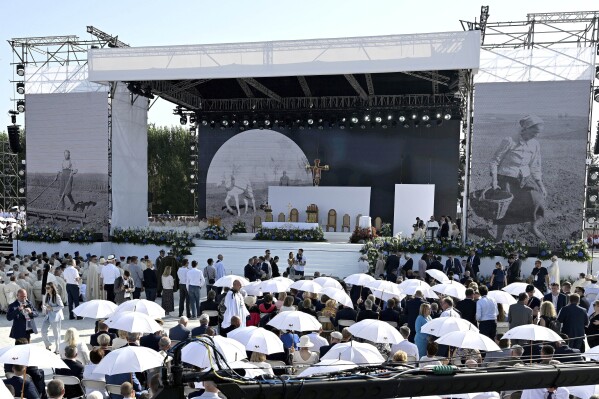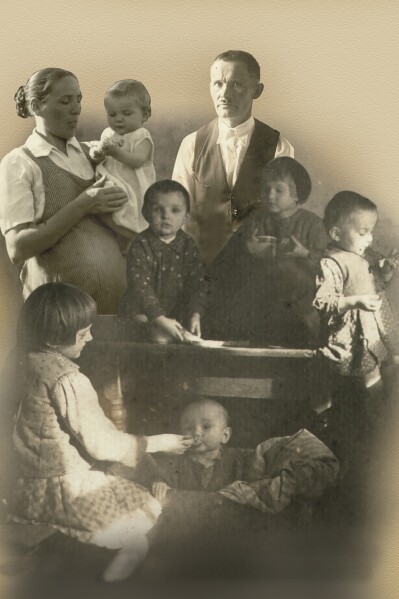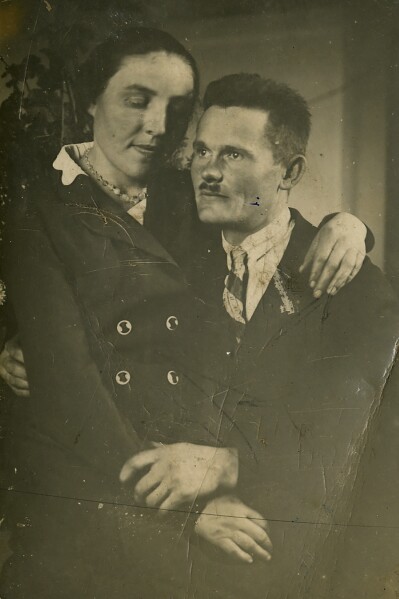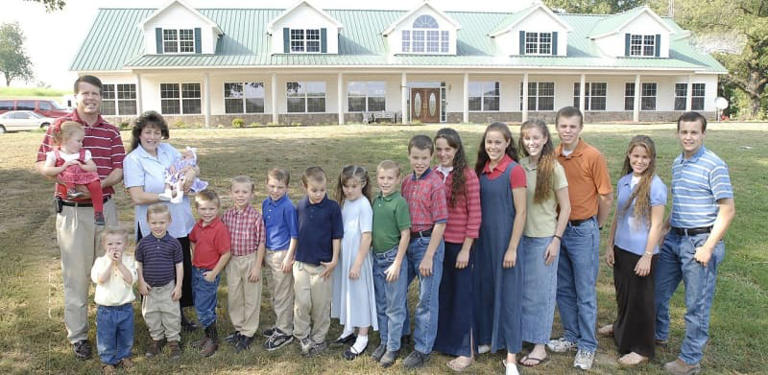By AFP
September 10, 2023

Children and granddaughters of Jewish survivor Abraham Segal paid respect in a 2016 ceremony to the Ulma family, who hid Jews during Holocaust and WWII
- Copyright POOL/AFP Kenny HOLSTON
A Polish couple and their seven children, killed by Nazis during World War II for hiding Jews, will be beatified Sunday, the first time an entire family is given one of Catholicism’s highest honours.
The ceremony in the family’s hometown of Markowa in south-east Poland will be attended by over 30,000 people, including 80 bishops, 1,000 priests, the country’s chief rabbi and an Israeli delegation.
It was there, on March 24, 1944, that German police acting on a tip-off shot dead Jozef Ulma and his wife Wiktoria, who was seven months pregnant and partially gave birth during the execution.
Their children, Stanislawa, Barbara, Wladyslav, Franciszek, Antoni and Maria, aged between two and eight, were killed too, along with the eight Jews the family had been hiding in the attic.
The eight — Shaul Goldmann and his five children, including his daughter Lea Didner and her five-year-old daughter, and Golda Gruenfeld — were also shot, before the family farmhouse was looted and set on fire.
The police fired up into the attic from the floor below, “and the blood of the victims began to drip from the ceiling… onto a photograph of two Jewish woman lying on a table below”, Vatican News said.
That photograph “has been preserved as a ‘relic'”, it said.
– Baptism of blood –
The massacre followed “a story of love and friendship”, said Italian journalist Manuela Tulli, who has written a book on the family along with Polish historian and priest Pawel Rytel-Andrianik.
“When the Jews asked for help, they opened their doors. They lived together for a year and a half, cooking and eating together”, Tulli told AFP.
Jozef Ulma was a keen photographer as well as a farmer, and photographs he took that survive reveal the family’s life through simple, everyday scenes.
“We see the children running barefoot in the grass, doing their homework, the mother hanging out the washing,” Tulli said.
The families were denounced by a Polish policeman. And after they were executed, 24 Jews in Markowa were murdered by their Polish neighbours.
The Ulma family will be the first ever to be beatified, a key step on a possible path to sainthood in the Catholic Church.
And in a rare move, the Ulmas’ newborn seventh child will also earn the title of “blessed”.
The child is eligible for beatification through the concept of “baptism of blood”, having been born “at the time of the mother’s martyrdom”, according to the Vatican’s department for saints.
Usually people need to have performed a miracle to be eligible for beatification, but martyrs are exempt.
Jozef and Wiktoria Ulma were recognised by Israel in 1995 as members of the “Righteous among the Nations”, an honour for non-Jews who tried to save Jews from Nazi extermination.
The family also has a museum dedicated to it in Markowa and in 2018 Poland decreed 24 March — the date of the massacre — a day of remembrance for Poles who rescued Jews during the German occupation.
A Polish couple and their seven children, killed by Nazis during World War II for hiding Jews, will be beatified Sunday, the first time an entire family is given one of Catholicism’s highest honours.
The ceremony in the family’s hometown of Markowa in south-east Poland will be attended by over 30,000 people, including 80 bishops, 1,000 priests, the country’s chief rabbi and an Israeli delegation.
It was there, on March 24, 1944, that German police acting on a tip-off shot dead Jozef Ulma and his wife Wiktoria, who was seven months pregnant and partially gave birth during the execution.
Their children, Stanislawa, Barbara, Wladyslav, Franciszek, Antoni and Maria, aged between two and eight, were killed too, along with the eight Jews the family had been hiding in the attic.
The eight — Shaul Goldmann and his five children, including his daughter Lea Didner and her five-year-old daughter, and Golda Gruenfeld — were also shot, before the family farmhouse was looted and set on fire.
The police fired up into the attic from the floor below, “and the blood of the victims began to drip from the ceiling… onto a photograph of two Jewish woman lying on a table below”, Vatican News said.
That photograph “has been preserved as a ‘relic'”, it said.
– Baptism of blood –
The massacre followed “a story of love and friendship”, said Italian journalist Manuela Tulli, who has written a book on the family along with Polish historian and priest Pawel Rytel-Andrianik.
“When the Jews asked for help, they opened their doors. They lived together for a year and a half, cooking and eating together”, Tulli told AFP.
Jozef Ulma was a keen photographer as well as a farmer, and photographs he took that survive reveal the family’s life through simple, everyday scenes.
“We see the children running barefoot in the grass, doing their homework, the mother hanging out the washing,” Tulli said.
The families were denounced by a Polish policeman. And after they were executed, 24 Jews in Markowa were murdered by their Polish neighbours.
The Ulma family will be the first ever to be beatified, a key step on a possible path to sainthood in the Catholic Church.
And in a rare move, the Ulmas’ newborn seventh child will also earn the title of “blessed”.
The child is eligible for beatification through the concept of “baptism of blood”, having been born “at the time of the mother’s martyrdom”, according to the Vatican’s department for saints.
Usually people need to have performed a miracle to be eligible for beatification, but martyrs are exempt.
Jozef and Wiktoria Ulma were recognised by Israel in 1995 as members of the “Righteous among the Nations”, an honour for non-Jews who tried to save Jews from Nazi extermination.
The family also has a museum dedicated to it in Markowa and in 2018 Poland decreed 24 March — the date of the massacre — a day of remembrance for Poles who rescued Jews during the German occupation.
The Vatican beatifies a Polish family of 9 killed by the Nazis for sheltering Jews

Crowd attending a Mass in which the Vatican beatified the Polish Ulma family, including small children, who were killed by the Nazis in 1944 for having sheltered Jews, in the Ulmas’ home village of Markowa Poland, on Sunday, Sept. 10, 2023. The Vatican beatified also the Ulmas’ unborn child, saying it was born during the killings and was baptized in the martyred mother’s blood. (AP Photo)

Crowd attending a Mass in which the Vatican beatified the Polish Ulma family, including small children, who were killed by the Nazis in 1944 for having sheltered Jews, in the Ulmas’ home village of Markowa Poland, on Sunday, Sept. 10, 2023. The Vatican beatified also the Ulmas’ unborn child, saying it was born during the killings and was baptized in the martyred mother’s blood.
This undated photo shows Polish farmer Jozef Ulma with his pregnant wife Wiktoria and their six children. The Ulmas were killed with their children by the Nazis in 1944 for having sheltered Jews during World War II. The Ulma family, including the child that Wiktoria was pregnant with, are being beatified by the Vatican in a ceremonious Mass in their home village of Markowa, Poland, on Sunday, Sept. 10, 2023.
Crowd attending a Mass in which the Vatican beatified the Polish Ulma family, including small children, who were killed by the Nazis in 1944 for having sheltered Jews, in the Ulmas’ home village of Markowa Poland, on Sunday, Sept. 10, 2023. The Vatican beatified also the Ulmas’ unborn child, saying it was born during the killings and was baptized in the martyred mother’s blood. (AP Photo)
Crowd attending a Mass in which the Vatican beatified the Polish Ulma family, including small children, who were killed by the Nazis in 1944 for having sheltered Jews, in the Ulmas’ home village of Markowa Poland, on Sunday, Sept. 10, 2023. The Vatican beatified also the Ulmas’ unborn child, saying it was born during the killings and was baptized in the martyred mother’s blood.
This undated photo shows Polish farmer Jozef Ulma with his pregnant wife Wiktoria and their six children. The Ulmas were killed with their children by the Nazis in 1944 for having sheltered Jews during World War II. The Ulma family, including the child that Wiktoria was pregnant with, are being beatified by the Vatican in a ceremonious Mass in their home village of Markowa, Poland, on Sunday, Sept. 10, 2023.
(Mateusz Szpytma, Deputy head of Poland’s IPN history institute via AP)

This undated photo shows Polish farmer Jozef Ulma with his wife Wiktoria. The Ulmas were killed with their seven children by the Nazis in 1944 for having sheltered Jews during World War II. The Ulma family, including a child that Wiktoria was pregnant with, are being beatified by the Vatican in a ceremonious Mass in their home village of Markowa, Poland, on Sunday, Sept. 10, 2023.
This undated photo shows Polish farmer Jozef Ulma with his wife Wiktoria. The Ulmas were killed with their seven children by the Nazis in 1944 for having sheltered Jews during World War II. The Ulma family, including a child that Wiktoria was pregnant with, are being beatified by the Vatican in a ceremonious Mass in their home village of Markowa, Poland, on Sunday, Sept. 10, 2023.
(Mateusz Szpytma, Deputy head of Poland’s IPN history institute via AP)
BY MONIKA SCISLOWSKA
September 10, 2023
WARSAW, Poland (AP) — In an unprecedented move, the Vatican on Sunday beatified a Polish family of nine — a married couple and their small children — who were executed by the Nazis during World War II for sheltering Jews.
During a ceremonious Mass in the village of Markowa, in southeastern Poland, papal envoy Cardinal Marcello Semeraro read out the Latin formula of the beatification of the Ulma family signed last month by Pope Francis.
In his homily Semeraro noted that for their “gesture of hospitality and care, of mercy” the Ulmas “paid the highest price of martyrdom.”
A contemporary painting representing Jozef and a pregnant Wiktoria Ulma with their children was revealed near the altar. A procession brought relics taken from their grave to the altar. It was the first time that an entire family has been beatified.
At the Vatican, speaking to the public from a window in St. Peter’s Square, Pope Francis said the Ulmas “represented a ray of light in the darkness” of the war and should be a model for everyone in “doing good and in the service of those in need.”
The pope then invited the crowd below to applaud the family, and he clapped his hands.
September 10, 2023
WARSAW, Poland (AP) — In an unprecedented move, the Vatican on Sunday beatified a Polish family of nine — a married couple and their small children — who were executed by the Nazis during World War II for sheltering Jews.
During a ceremonious Mass in the village of Markowa, in southeastern Poland, papal envoy Cardinal Marcello Semeraro read out the Latin formula of the beatification of the Ulma family signed last month by Pope Francis.
In his homily Semeraro noted that for their “gesture of hospitality and care, of mercy” the Ulmas “paid the highest price of martyrdom.”
A contemporary painting representing Jozef and a pregnant Wiktoria Ulma with their children was revealed near the altar. A procession brought relics taken from their grave to the altar. It was the first time that an entire family has been beatified.
At the Vatican, speaking to the public from a window in St. Peter’s Square, Pope Francis said the Ulmas “represented a ray of light in the darkness” of the war and should be a model for everyone in “doing good and in the service of those in need.”
The pope then invited the crowd below to applaud the family, and he clapped his hands.
Those gathered in Markowa watched Francis’ address on giant screens placed by the altar.
Last year, Francis pronounced the deeply Catholic Ulma family, including the child that Wiktoria Ulma was pregnant with, martyrs for the faith. The Ulmas were killed at home by German Nazi troops and by Nazi-controlled local police in the small hours of March 24, 1944, together with the eight Jews they were hiding at their home, after they were apparently betrayed.
Jozef Ulma, 44, was a farmer, Catholic activist and amateur photographer who documented family and village life. He lived with his 31-year-old wife Wiktoria; their daughters Stanislawa, 7; Barbara, 6; Maria, 18 months; and sons Wladyslaw, 5; Franciszek, 3; and Antoni, 2.
With them were killed 70-year-old Saul Goldman with his sons Baruch, Mechel, Joachim and Mojzesz, along with Golda Grunfeld and her sister Lea Didner with her little daughter Reszla, according to Poland’s state Institute of National Remembrance, IPN, which has meticulously documented the Ulmas’ story.
Giving the orders was Lt. Eilert Dieken, head of the regional Nazi military police. After the war he served in the police in Germany. Only one of his subordinates, Josef Kokott, was convicted in Poland over the killings, dying in prison in 1980. The suspected betrayer was Wlodzimierz Les, a member of the Nazi-controlled local police. Poland’s wartime resistance sentenced him to death and executed him in September 1944, according to IPN.
The Catholic Church had faced a dilemma in beatifying Wiktoria’s unborn child and declaring it a martyr because, among other things, it had not been baptized, which is a requirement for beatification.
The Vatican’s Dicastery for the Causes of Saints issued a clarification saying the child was actually born during the horror of the killings and received “baptism by blood” of its martyred mother.
The clarification was issued Sept. 5 by Cardinal Semeraro, who is the prefect of the Vatican’s saint-making office.
Polish President Andrzej Duda along with the ruling party leader Jaroslaw Kaczynski and Prime Minister Mateusz Morawiecki, as well as Poland’s chief rabbi, Michael Schudrich, attended the celebration in Markowa, and thousands of pilgrims came from across Poland to take part.
Poland’s conservative ruling party has been stressing family values and also the heroism of Poles during the war and the beatification ceremony added to its intense political campaigning ahead of the Oct. 15 parliamentary elections in which the Law and Justice party wants to win an unprecedented third term.
After the Mass, Duda, who is the ruling party’s ally, spoke to thank Francis for beatifying the Ulmas. He also stressed that the ceremony had a political dimension because it “told the truth about the Nazi German occupation” of Poland during the war. Poland’s government is seeking reparations from Germany for wartime damages, but Berlin says the matter had been closed.
The Ulma beatification poses several new theological concepts about the Catholic Church’s ideas of saints and martyrs that also have implications for the anti-abortion movement because of the baby in the mother’s womb, said the Rev. Robert Gahl, a professor of ethics at the Catholic University of America and Rome’s Pontifical Holy Cross University.
The Vatican stated that the child was “born” at the moment the mother was executed. In doing so, the Vatican also affirmed that the killers intended to kill the child out of hatred for the faith, a requirement for a martyrdom and beatification declaration, Gahl told The Associated Press.
After beatification, a miracle attributed to the Ulmas’ intercession would be necessary for their eventual canonization, as the church’s sainthood process is called.
Israel’s Yad Vashem Institute in 1995 recognized the Ulmas as Righteous Among Nations who gave their lives trying to save Jews during the Holocaust.
In Poland, they are a symbol of the bravery of thousands of Poles who took the utmost risk while helping Jews. By the occupying Nazis’ decree, any assistance to Jews was punished with summary execution. A Museum of Poles Saving Jews During World War II was opened in Markowa in 2016.
Poland was the first country to be invaded by Nazi Germany, on Sept. 1, 1939. Around 6 million of its citizens were killed during the war, half of them Jews.
___
Nicole Winfield and Frances D’Emilio contributed to this report from Rome.
Last year, Francis pronounced the deeply Catholic Ulma family, including the child that Wiktoria Ulma was pregnant with, martyrs for the faith. The Ulmas were killed at home by German Nazi troops and by Nazi-controlled local police in the small hours of March 24, 1944, together with the eight Jews they were hiding at their home, after they were apparently betrayed.
Jozef Ulma, 44, was a farmer, Catholic activist and amateur photographer who documented family and village life. He lived with his 31-year-old wife Wiktoria; their daughters Stanislawa, 7; Barbara, 6; Maria, 18 months; and sons Wladyslaw, 5; Franciszek, 3; and Antoni, 2.
With them were killed 70-year-old Saul Goldman with his sons Baruch, Mechel, Joachim and Mojzesz, along with Golda Grunfeld and her sister Lea Didner with her little daughter Reszla, according to Poland’s state Institute of National Remembrance, IPN, which has meticulously documented the Ulmas’ story.
Giving the orders was Lt. Eilert Dieken, head of the regional Nazi military police. After the war he served in the police in Germany. Only one of his subordinates, Josef Kokott, was convicted in Poland over the killings, dying in prison in 1980. The suspected betrayer was Wlodzimierz Les, a member of the Nazi-controlled local police. Poland’s wartime resistance sentenced him to death and executed him in September 1944, according to IPN.
The Catholic Church had faced a dilemma in beatifying Wiktoria’s unborn child and declaring it a martyr because, among other things, it had not been baptized, which is a requirement for beatification.
The Vatican’s Dicastery for the Causes of Saints issued a clarification saying the child was actually born during the horror of the killings and received “baptism by blood” of its martyred mother.
The clarification was issued Sept. 5 by Cardinal Semeraro, who is the prefect of the Vatican’s saint-making office.
Polish President Andrzej Duda along with the ruling party leader Jaroslaw Kaczynski and Prime Minister Mateusz Morawiecki, as well as Poland’s chief rabbi, Michael Schudrich, attended the celebration in Markowa, and thousands of pilgrims came from across Poland to take part.
Poland’s conservative ruling party has been stressing family values and also the heroism of Poles during the war and the beatification ceremony added to its intense political campaigning ahead of the Oct. 15 parliamentary elections in which the Law and Justice party wants to win an unprecedented third term.
After the Mass, Duda, who is the ruling party’s ally, spoke to thank Francis for beatifying the Ulmas. He also stressed that the ceremony had a political dimension because it “told the truth about the Nazi German occupation” of Poland during the war. Poland’s government is seeking reparations from Germany for wartime damages, but Berlin says the matter had been closed.
The Ulma beatification poses several new theological concepts about the Catholic Church’s ideas of saints and martyrs that also have implications for the anti-abortion movement because of the baby in the mother’s womb, said the Rev. Robert Gahl, a professor of ethics at the Catholic University of America and Rome’s Pontifical Holy Cross University.
The Vatican stated that the child was “born” at the moment the mother was executed. In doing so, the Vatican also affirmed that the killers intended to kill the child out of hatred for the faith, a requirement for a martyrdom and beatification declaration, Gahl told The Associated Press.
After beatification, a miracle attributed to the Ulmas’ intercession would be necessary for their eventual canonization, as the church’s sainthood process is called.
Israel’s Yad Vashem Institute in 1995 recognized the Ulmas as Righteous Among Nations who gave their lives trying to save Jews during the Holocaust.
In Poland, they are a symbol of the bravery of thousands of Poles who took the utmost risk while helping Jews. By the occupying Nazis’ decree, any assistance to Jews was punished with summary execution. A Museum of Poles Saving Jews During World War II was opened in Markowa in 2016.
Poland was the first country to be invaded by Nazi Germany, on Sept. 1, 1939. Around 6 million of its citizens were killed during the war, half of them Jews.
___
Nicole Winfield and Frances D’Emilio contributed to this report from Rome.



















